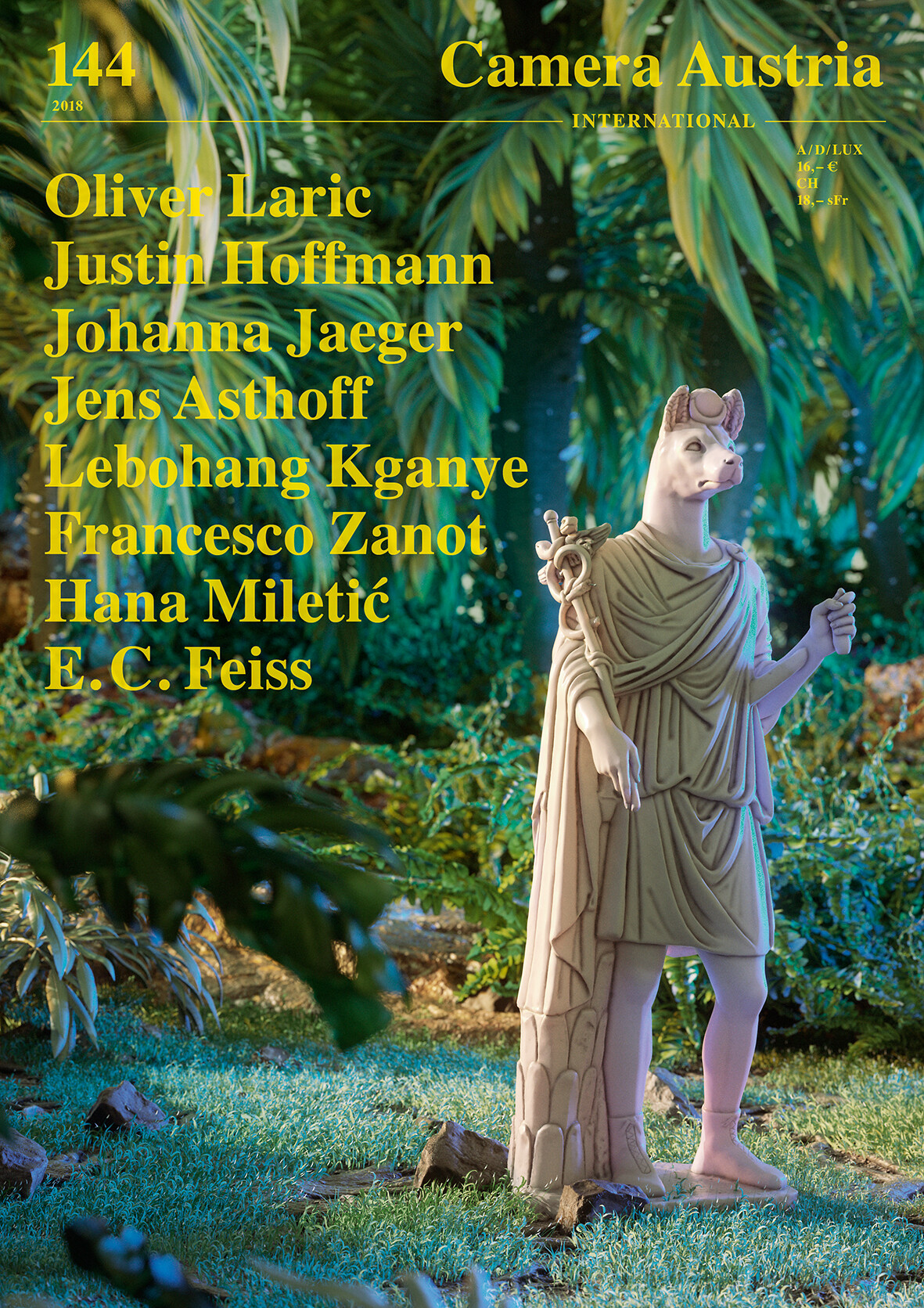Featuring: Oliver Laric, Justin Hoffmann, Johanna Jaeger, Jens Asthoff, Lebohang Kganye, Francesco Zanot, Hana Miletić, E.C. Feiss, Oliver Leu, Paula Artés, Alexandra Soldatova, Jenny Schäfer, Wenzel Stählin, Julia Gaisbacher
Publication date: December 12, 2018
Order here
Photography has long since ceased being reduced to classical two-dimensional formats whose presentation solely is played out in the form of artwork mounted on walls. Preceding the actual artistic work is an elaborate conceptual and research-oriented practice that is an essential part of the work ultimately on show. Thus, the artists presented in Camera Austria International No. 144 likewise approach photography from what is often a process-based interest, querying the medium as to its performative qualities, which at times also reach into the digital and sculptural.
In his work, Oliver Laric relies on processes of 3D modeling. Using this 3D method, he often lends form to sculptures based on ancient statues or reliefs. Yet these works only partially encompass his artistic activity. First, Laric creates a comprehensive, self-rendered archive of 3D scans that he provides, free of charge, to other persons on his website as well as on professional platforms like Turbo-Squid. So “various levels of research, publication, and distribution” complement the scanning of the original objects, as Justin Hoffmann writes in his essay.
Johanna Jaeger also engages with the borderline areas of the photographic. In her series, she focuses on their origins and media-related premises. It is from varying perspectives that her interest revolves around the question of how photography develops, which forms it assumes, and how it may transform itself. Jens Asthoff views the aspect of time as one of the central characteristics of Jaeger’s series: “She develops her artistic work with a view to a core property of photography, its role as a (reproductive) temporal medium… The artist’s characteristic visual language revolves around fluid-ephemeral aspects, such as clouds, color gradients, and the processual dissolution of form. She explores phenomena of light and exposure or thematizes solid-sedimented facets…”
Lebohang Kganye extends her photographic practice into the performative, including the staging of three-dimensional spaces. Her family’s photo albums serve as a point of departure for the exploration of her own biography and also for her probing of photography as a medium. In Kganye’s series “Ke Lefa Laka: Her-Story” (2013), pictures of her mother are superimposed with spectral-like self-portraits in which she wears her mother’s dresses. In later works, she re-creates various rooms seen in the family albums in the form of miniature stage sets and here allows the people depicted in the albums to encounter “real” people. This way of uniting the past and the present leads the evident nature of photography ad absurdum, as Francesco Zanot explains.
Hana Miletić uses photography as a medium for orientation while surveying social realities, calling her artistic practice, in which she documents her surrounding environment, “Street Photography.” Yet these explorations also include other mediums, with Miletić availing herself of a broadened photographic space and creating textile objects through processes that are at times collaborative. For E. C. Feiss, “the suppression of the photograph in service to material… constitutes both the statement of the work’s politics and its critique of photography… The documentary particulars of the photographs are transformed in their conversion to textile, where social detail is recorded but equally withheld, absorbed by the composition dictated by the weave.”
The issue is rounded off by Jan Wenzel’s “The Revolving Bookshelf” and a comprehensive review section with responses to recent national and international exhibitions including Cauleen Smith, ICA Philadelphia; The Black Image Corporation, Osservatorio of Fondazione Prada, Milan; Antarktika, Kunsthalle Vienna; Helen Levitt, Albertina, Vienna; Sara Cwynar, Minneapolis Institute of Art; Astrid Klein, Sammlung Falckenberg, Hamburg, James N. Kienitz Wilkins, Gasworks, London; Calin Aoun, MAXXI, Rome, and many others.
Camera Austria International
published quarterly, 88 pages, German / English


